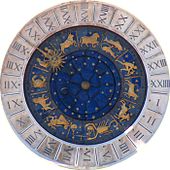Astrocartography
| Astrology |
|---|
 |
| Background |
| Traditions |
| Branches |
| Astrological signs |
| Symbols |
Astrocartography (called "astrogeography" in Europe in earlier years) is one of several methods of locational astrology, which purports to identify varying life conditions through differences in location.[vague]
Technique
Developed and popularized by American astrologer Jim Lewis (1941-1995),[1] astrocartography is a locational astrology system that focuses on elements of the natal chart, by identifying these factors on a world "Astro*Carto*Graphy Map." Lewis' Astro*Carto*Graphy maps show all locations on the earth where planets were "angular" (rising, setting, on the zenith or nadir) at the moment of an event like a person's birth. An "angular" planet is one that is conjunct one of these four angles (Ascendant, Descendant, MC or IC). These locations are displayed in the form of lines on the Astro*Carto*Graphy world map.
Application
These maps are used by 'astro-cartographers' to counsel their clients on plans for relocation or travel.[2] As such, they are part of a general branch of astrology known as locational astrology or "relocation astrology". Other techniques used for this purpose include local space mapping, relocated birth charts, and city incorporation charts.
A*C*G Map Sources & Variations
Lewis created the trademark "Astro*Carto*Graphy" to refer to his map and granted licenses to three companies to customize his authorized maps and accompanying material: Astro Numeric Services (USA), Equinox Astrology (UK and Australia) and Astrodata (Switzerland). Other similar maps were developed showing additional locational factors Lewis rejected. One example is the "Astrolocality Map" developed by Astro Computing Services of San Diego. In addition to the A*C*G lines showing conjunctions to the angles, this version includes planetary squares, trines, and other aspects.[3]
See also
References
- ^ Biography of Jim Lewis by Robert Currey Part 1: Reprinted from the Astrological Journal May/June 1995:
- ^ Carlson, S (April 15, 1988). "Astrology". Cellular and Molecular Life Sciences. 44 (4). Springer: 290–291. doi:10.1007/BF01961265.
Even in the 20th century, astrologers have remained strong in number and powerful in influence, and their art has developed into many diverse forms: Natal astrology, Horary astrology, Sabian astrology, Humanistic astrology, Medical astrology, Astro-cartography,... 'Astro-cartographers' frequently counsel clients to move to other parts of their country, and even to emigrate to where the astrological influences will supposedly be more favorable.
- ^ Davis, Martin (2008). From Here to There. An Astrologer's Guide to Astromapping. Dorset: Wessex Astrologer. p. 8. ISBN 978-1902405278.
Neil F. Michelson (1931-1990) of Astro Computing Services began offering "Astrolocality Maps" in 1984. These geographic maps of angularity (similar to A*C*G maps) were notable for their inclusion of aspect lines (60,90 or 120°) from the Midheaven or Ascending lines.
Further reading
- The Astro*Carto*Graphy Book of Maps, (1981) with Ariel Guttman, Llewellyn Publications
- The Psychology of Astro*Carto*Graphy (Contemporary Astrology), (posthumous), by Jim Lewis and Kenneth Irving. ISBN 0-14-019512-2.
- From Here to There - An Astrologer's Guide to Astromapping, an anthology of articles by locational astrologers edited by Martin Jay Davis. Published by the Wessex Astrologer. ISBN 978-1-902405-27-8.
- Astro*Carto*Graphy - Explanatory Handbook, (1976) by Jim Lewis.
